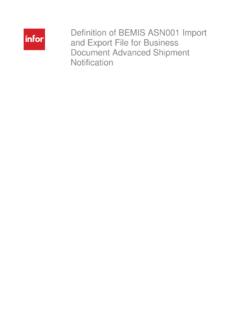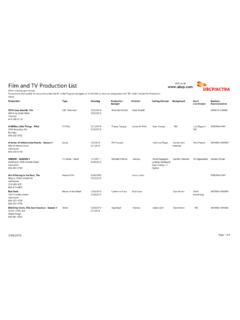Transcription of User Guide for BEMIS - EDI
1 Infor LN Electronic CommerceUser Guide for BEMISC opyright 2014 InforImportant NoticesThe material contained in this publication (including any supplementary information) constitutes and contains confidentialand proprietary information of gaining access to the attached, you acknowledge and agree that the material (including any modification, translationor adaptation of the material) and all copyright, trade secrets and all other right, title and interest therein, are the soleproperty of Infor and that you shall not gain right, title or interest in the material (including any modification, translation oradaptation of the material) by virtue of your review thereof other than the non-exclusive right to use the material solelyin connection with and the furtherance of your license and use of software made available to your company from Inforpursuant to a separate agreement, the terms of which separate agreement shall govern your use of this material and allsupplemental related materials ("Purpose").
2 In addition, by accessing the enclosed material, you acknowledge and agree that you are required to maintain suchmaterial in strict confidence and that your use of such material is limited to the Purpose described above. Although Inforhas taken due care to ensure that the material included in this publication is accurate and complete, Infor cannot warrantthat the information contained in this publication is complete, does not contain typographical or other errors, or will meetyour specific requirements. As such, Infor does not assume and hereby disclaims all liability, consequential or otherwise,for any loss or damage to any person or entity which is caused by or relates to errors or omissions in this publication(including any supplementary information), whether such errors or omissions result from negligence, accident or anyother Infor has taken due care to ensure that the material included in this publication is accurate and complete, Inforcannot warrant that the information contained in this publication is complete, does not contain typographical or othererrors, or will meet your specific requirements.
3 As such, Infor does not assume and hereby disclaims all liability,consequential or otherwise, for any loss or damage to any person or entity which is caused by or relates to errors oromissions in this publication (including any supplementary information), whether such errors or omissions result fromnegligence, accident or any other limitation, export control laws and other applicable export and import laws govern your use of this materialand you will neither export or re-export, directly or indirectly, this material nor any related materials or supplementalinformation in violation of such laws, or use such materials for any purpose prohibited by such AcknowledgementsThe word and design marks set forth herein are trademarks and/or registered trademarks of Infor and/or related affiliatesand subsidiaries. All rights reserved. All other company, product, trade or service names referenced may be registeredtrademarks or trademarks of their respective InformationU8912F USDocument 4, 2014 Publication date About this 1 Data 2 An overview of overview of 3 BEMIS - Design - design compatibility - compatibility - conversion compatibility - generic segment start and end element record 4 BEMIS - - of A IndexObjectivesThe objectives of this Guide are to describe the purpose of BEMIS , the contents of BEMIS and how youcan set up audienceThis user Guide is intended for the following categories of users: Users who develop business documents/EDI messages.
4 Users who want to understand what they can expect from a BEMIS business document/EDImessage as developed by summaryThe first chapter, Introduction, describes the purpose and the general characteristics of BEMIS in thecontext of following chapters describe the rules for designing BEMIS and the contents for the BEMIS document is also provided with a glossary list and an index, which you can find at the end of details on: The types of business documents and the related EDI messages, refer to user Guide for EDIB usiness Documents U8998 US. The content and structure of the business document types, refer to Document Definitions atInfor to read this documentThis document was assembled from online Help topics. As a result, references to other sections in themanual are presented as shown in the following example:For details, refer to Introduction. To locate the referred section, please refer to the Table of Contents oruse the Index at the end of the terms indicate a link to a glossary definition.
5 If you view this document online, you can clickthe underlined term to go to the glossary definition at the end of the document .Comments?We continually review and improve our documentation. Any remarks/requests for information concerningthis document or topic are appreciated. Please e-mail your comments to your e-mail, refer to the document number and title. More specific information will enable us to processfeedback LN Electronic Commerce | user Guide for BEMIS | 5 About this documentContacting InforIf you have questions about Infor products, go to the Infor Xtreme Support portal at we update this document after the product release, we will post the new version on this Web site. Werecommend that you check this Web site periodically for updated you have comments about Infor documentation, contact | Infor LN Electronic Commerce | user Guide for BEMISA bout this documentElectronic Data InterchangeElectronic data interchange (EDI) is used to exchange business documents between two systems.
6 Forexample, a customer sends a purchase order to a supplier through EDI after which the supplier respondsby sending an invoice to the customer electronically. Therefore, EDI eliminates the transfer of papercopies of business external standards of these business documents are defined that provide rules to the relatedbusiness processes, the business document structure, and the content. In Europe, the UN/ EDIFACT standard is used; in the United States, the standard is called ANSI. Moreover, industry-specific standardsare also used, such as SPEC2000 and AECMA for aerospace and defense, and VDA/ODETTE in theautomotive has its own internal standard, called BEMIS (Baan Electronic Message Interchange System). LNuses the BEMIS standard to generate and read messages. All external standards can be translated intothe internal BEMIS standard or generated from BEMIS by an EDI translator, which uses standard EDImessage formats that are supported by your business diagram shows the development of the various standards:Infor LN Electronic Commerce | user Guide for BEMIS | 71 Chapter 1 Introduction8 | Infor LN Electronic Commerce | user Guide for BEMISI ntroductionAn overview of BEMISIn Electronic Data Interchange, you can specify business documents of various external standards, suchas VDA, UN/ EDIFACT, Odette, and ANSI.
7 Baan Electronic Message Interchange System ( BEMIS ) isthe internal LN standard to which external standards are converted. Conversion of the internal standardto an external standard and vice versa is carried out by an EDI business documents/EDI messages include forecast information on schedules: VDA 4905 Odette DELINS UN/EDIFACT DELFOR ANSI X12 830 All of these documents are supported by the BEMIS business document BEMIS MRL001 (MaterialRelease).Infor LN Electronic Commerce | user Guide for BEMIS | 92 Chapter 2An overview of BEMISB usiness documents can also be used internally in a multisite environment. In this case, BEMIS messagesneed not be converted to an external elementsThe following elements are used for BEMIS : Business document (p. 10) EDI message (p. 11) Conversion setup (p. 11) Data segment (p. 11) Data element (p. 11)A business document includes one or more EDI messages. An EDI message includes one or multipledata segments with one or multiple data documentA business document describes a business process between trading supports these business documents: Order Schedule Delivery10 | Infor LN Electronic Commerce | user Guide for BEMISAn overview of BEMIS Freight Invoice Error HandlingEDI messageEDI messages are communicated between trading partners regarding a specific business supports these EDI messages.
8 Order (ORD) Order Acknowledgement/Response (ORS) Order Change (ORC) Order Change Acknowledgement/Response (OCA) Material Release (MRL) Shipping Schedule (SHP) Sequence Shipping Schedule (SEQ) Advance Shipment Notification (ASN) Receipt Discrepancy Notification (RDN) Invoice (INV) Remittance Advice (RAD) Load Information to Carrier (FML) Carrier Status Information (FMS) Error Notification (ERN) Message Status (STATUS)NoteThe Message Status (STATUS) can be used to update the status of previously generated EDI an incoming conversion setup exists for this setupThe conversion setup is related to the format of an EDI message within a specific service/feature segmentA data segment is the intermediate unit of information in an EDI message. A data segment consists ofa predefined set of functionally-related data elements that are identified by their sequential positionswithin the elementA data element is the smallest named item in the BEMIS standard.
9 It can represent a qualifier, a value,or a text, such as a LN Electronic Commerce | user Guide for BEMIS | 11An overview of BEMIS12 | Infor LN Electronic Commerce | user Guide for BEMISAn overview of BEMISBEMIS - design principlesA BEMIS business document must be designed following a predefined set of rules. If these rules arenot met, the business document does not comply with the BEMIS messageThe code of an EDI message within a business document includes the name and version (XXX999).The name is alphanumeric and the version is numeric. Both have a length of order EDI Message is called ORD Name 001 ORD for OrderIn situations such as the following, multiple versions of an EDI message can exist: 80% of the customers require a simple version and 20% require a complex version of themessage. Two external standards setupIf changes are made to the EDI message within a service/feature pack, a new conversion setup is createdfor that feature format of the conversion setup is XXX999, in which: The first three positions are equal to the first three positions of the EDI MessageInfor LN Electronic Commerce | user Guide for BEMIS | 133 Chapter 3 BEMIS - Design principles The last 3 positions are sequentialEach time a change is made, the number increases with order EDI Message is called ORD first conversion setup is called ORD001 in Infor are made to EDI Message ORD001 in Infor LN SP1.
10 This results in a new conversion setupcalled Infor LN FP2 no changes are made to EDI Messages ORD001. As a result, the conversion setupdoes not change and remains segmentEach data segment has a unique code within an EDI message. The format of the data segment codeis SA99. The unique code of the first data segment is SA1, the second is SA2, the tenth is SA10, andso compatibility - positionA business document consists of multiple EDI messages that contain multiple data segments withmultiple positions. On those positions, data elements can be defined. Once the functional meaning ofa position is determined, do not change example, on the data segment Order Line, position 10 contains the item ( ). In a newversion of a business document the item must still be on position !To minimize the impact when implementing a new version/release or feature pack of LN, do not changepositions. If the functional meaning of a position changes, you must also adapt the EDI translationsoftware that converts the external standard into the internal ( BEMIS ) standard or the other way compatibility - conversion setupWithin a specific LN version/release, you can use business documents of older feauture packs in newfeature packs.








